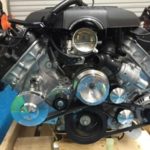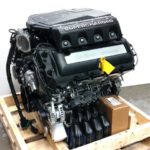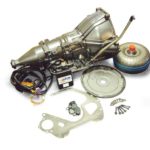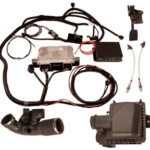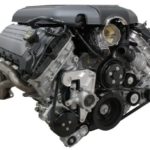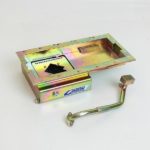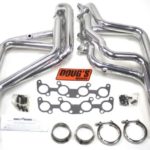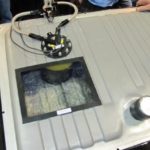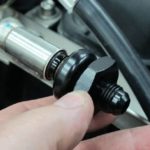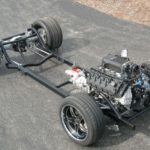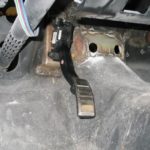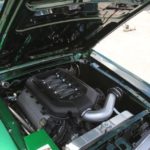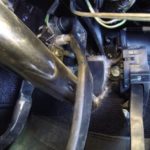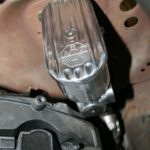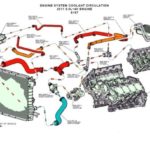Classic Bronco Coyote Swap Guide
It’s gotten easier to drop a modern Coyote engine fitted to a Classic 1966-77 Bronco.
There is no argument that the 5.0L dual overhead cam (DOHC) known as the “Coyote” modular V-8, is great. So with Over 460 hp without the use of a supercharger,
The Coyote’s cylinder head design, camshafts, and trick electronic valve timing control each cam controlled with independence
This means a new modular not only made good power but actually had usable torque down low. Something the Mustang was missing since its pushrod days.
The Coyote is a wide engine to fit into the engine bay. There are several schools of thought here, including all-new front suspension systems. They remove the shock towers completely, or strut-based front suspensions. It requires the very top of the shock tower to keep, but the rest can be trimmed back for engine clearance. The strut-based systems are a bolt-in. Though cutting and welding are required for trimming the shock towers. There are front suspension conversions in the aftermarket. If your front frame rails are in rust.
If you are going to add or adapt to your power steering, power brakes, and A/C, the serpentine kit offered with resolve this.
VIEW OUR COMPLETE Coyote Engine / 6 Speed 4 x 4 Transmission Package
If you’re looking for a little more go-power, A Supercharged Coyote 5.0L crate engine is available. . Go directly to this link for the 700 HP Coyote Street Beast
For the transmission, most Bronco Owners opt for the 6 speed or 10 speed Automatic Transmissions. Which of course is a huge improvement over the 3 speed C4 Transmissions. The 6 speed is a bit easier to install over the 10 speed being the a bit wider. We supply more of the 6 speeds. They typically don’t require any mods with the Transmission Tunnel when having a suspension / body lift of2-3 inches
- Smart Shift electronics,
- manual lever sensor,
- block plate, flexplate,
- converter and attaching bolts.
The Coyote is a drive-by-wire modular engine, the AOD its a throttle valve (TV) shift control cable. They are not suitable for this application. A constant pressure valve body, which does not need the TV cable operation. It would rectify this issue, but you’re better off stepping up to the 4R70W or 6R80W
No more dropping a valve body a dozen times tweaking springs and hoping you got it right. You can purchase the entire 4R70W conversion kit here.
The Ford 6R80 six-speed automatic has become tranny of choice for the early Broncos. There is currently a plug-and-play standalone controller for the coyote.
As mentioned earlier, wiring the Coyote is a breeze if you use the Control Pack kit. It includes;
- The body harness,
- Inlet ducting
- And air box,
- Drive-by-wire throttle pedal,
- Oxygen sensors,
- And fuse box.
Once connecting, the harness to the crate engine and the pedal. You will have about six wire leads to connect to power the engine.
The Coyote crate engine does not come packaged with any drive accessories. A couple options one is an alternator kit with drive belt for the Coyote. Which includes the Boss 302 alternators, high-tension belt tensioner, and serpentine drive belt.
If you’re running manual steering and no A/C, the alternator kit is all you need. But if you’re looking to go all out with full accessories then you’ll need to i One such setup is this Front Runner system. The kit uses the industry standard Sanden A/C compressor and GM Type II power steering pump. Along with custom brackets and spring-loaded belt tensioner. To offer a very compact setup on the passenger side of the engine.
5.0 Coyote Engine Swap Kit
The Gen 2 oil pan fits most Bronco Chassis with a small body or suspension lift. .
Some builders use the stock iron manifolds. With the Coyote swap headers for 1966-77 Bronco. And you designed it to fit the TCI and Heidts Pro-G IFS systems, though they may work with other suspensions.
To feed that Coyote 5.0L’s EFI you’re going to need Fuel Tank EFI fuel system. The stock single feed line is not EFI capable. It is not to mention you’ll need a return line to the tank, a high-pressure EFI pump, and more. You have a few options here, one being the Aeromotive Phantom fuel system. In a nutshell, it is a pump, mounting bracket, and sump in one unit. Simply cut a hole in your tank and drop it in. Aeromotive offers the Phantom by itself and as a kit with EFI regulator, fittings, filter, and more. Add the length of -6 AN hose you need and an adapter fitting for the fuel rail and you’re all set.
This is the Aeromotive fuel rail adapter for the modular engine like the Coyote. Slip the adapter into the open fuel rail on your crate engine until it locks in place. The opposite end is machined with a male -6 AN fitting for a standard AN hose connection. The Coyote, being return fuel from the factory, only has one fuel rail connection. So the fuel line routing needs to be set up. The fuel return line comes off of the fuel pressure regulator. With one pressure line connecting to the engine.
Cooling System
Cooling the Coyote 5.0L in your swap isn’t much difficult. The engine is fitting with an aluminum billet hose to hookup your radiator hoses more easily. There is a complete Radiator, Electric Fan and Shroud kit for the early Broncos made by champion. Link here
Early Coyote Swap
The Control Pack needs a drive-by-wire pedal. It will need you to mount thorough a custom-fabricated mount. This is an earlier pedal shown installed here, but it gives you an idea of what needs to complete. This fabbed bracket from steel sheet and bolts welded to it as mounting studs at the top and a nut for a bolt at the bottom.
The brake master cylinder. Due to the width of the Coyote 5.0L even using a manual brake master cylinder. It’s mounted to the firewall can be an issue, The answer is to move the master cylinder over roughly 1 3/4 inches.
This will need widening the pedal support, adding length to the brake pedal arm pin, and moving the clutch pedal over as well. If it’s a manual trans car. You can see in these photos, how they moved the master cylinder over and modified the brake pedal and support accordingly.
Speaking of power brakes, as you can imagine, there is no way you’re getting a traditional vacuum diaphragm booster in such a tight spot. We’ve used hydraulic assist units in previous builds, aka hydroboost. Need power steering and some additional line plumbing.
Most of the coolant hoses come with the harness kit.
Installation Master Kit for Classic Bronco Coyote Swap
This Kit is ideal for finishing the install or a Gen 2 or Gen 3 Coyote crate engine / Auto transmission into an 1966-77 Bronco. This installation package factored with the engine and transmission package will include the needed swap parts for fitting the engine, exhaust, cooling system and accessory drive kit etc…
-
Computer Mounting Bracket –
-
Coyote low profile Headers for Bronco Swaps
-
Transmission cooler Fitting Kit with Trans Cooler – Bolts, Midplate and Inspection Plate
-
Heater Hose Kit for Hot Water Tubes, Coolant bleedscrew –
-
Engine Mount / Cross Member Kit
-
Radiator, Electric Fan and Shroud Assy
-
Universal Braided Fuel line Kit
-
Cold Air kit. Cut to Fit Bronco
-
In line Fluid Thermostat

